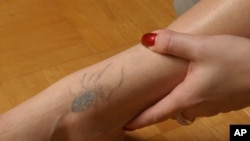It is estimated that 30 percent of Americans have one or more tattoos—permanent words or pictures on their skin.
Nearly one in four of them want their tattoos removed, one doctor says.
Doctor Paul Freidman is a spokesman for the American Society for Dermatological Surgery. He also is director of the Dermatology & Laser Surgery Center in Houston and New York. The business provides laser operations to remove tattoos.
Friedman told the Associated Press that people of all age groups are seeking to remove their tattoos. He has noted an increase in millennials: people who have entered adulthood since 2000.
Friedman’s group estimates its members performed 85,000 tattoo removal operations in 2017. That is the most recent year for which numbers are available.
Dermatologists say the latest equipment can remove most tattoos without permanently damaging the skin. But the process can be long and costly. And health insurance generally does not pay for the removals.
There are three ways to remove the permanent ink writing of a tattoo. One method uses lasers -- devices that produce an intense beam of light. The laser sends light of different wavelengths for each color used in the tattoo. The short but powerful light beam damages skin cells causing the ink inside to break apart into small pieces. The body’s own immune system then gets rid of the remains of the ink. An anesthetic drug is used to limit pain.
Laser removal requires several treatments; the exact number depends on the size of the tattoo. And the cost can be high -- from $450 to $1,000 for each treatment.
Another way to remove a tattoo is called dermabrasion. That means the top layer of skin is removed by rubbing a tool against it. Dr. Eric Bernstein of the Mainline Center for Laser Surgery in the state of Pennsylvania says this method can leave big scars, or marks on the skin.
It also is possible to remove the skin by cutting away the top layers of skin in a medical operation. This can be done for small tattoos or to remove tattoos quickly because a person has had an allergic reaction to the ink.
Bernstein is president of the American Society of Laser Medicine & Surgery. He advises people seeking to remove tattoos to wait until they are ready to do it in the right way. He warns that low-cost methods can leave permanent scars.
Ryan Tucker is a 39-year-old firefighter from Texas. He spent $6,000 on 10 laser treatments to remove the tattooed name of his former wife.
“I was young and stupid and thought it was a good way to show affection, which it’s not,” Tucker said. He added that the treatment was much less painful than the process of getting the tattoo.
Bernstein also advises people to find a dermatologist who is experienced and certified in laser medical operations.
He says to make sure that the doctor has the most recent lasers for tattoo removal. And, he says people should ask to see pictures that show the results of treatment on people with a similar skin color.
He also advises people to follow all instructions in caring for your skin after each treatment.
Finally, do not try to finish the process too quickly. Waiting a few months between treatments can reduce the number needed and can reduce costs.
I’m Mario Ritter Jr.
Linda Johnson reported this story for the Associated Press. Mario Ritter Jr. adapted it for VOA Learning English. Ashley Thompson was the editor.
________________________________________________________________
Words in This Story
ink –n. a liquid used in pens for writing or printing
beam –n. a line of light come from a source
allergic –adj. related to a bad reaction to a substance or condition
certified –adj. having the official requirements needed to do a certain kind of work
We want to hear from you. Write to us in the Comments section, and visit our Facebook page.






